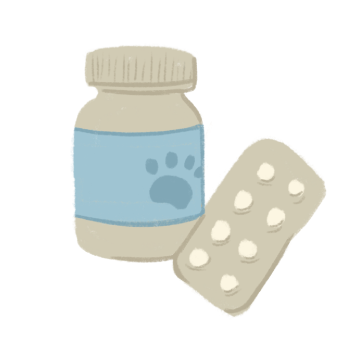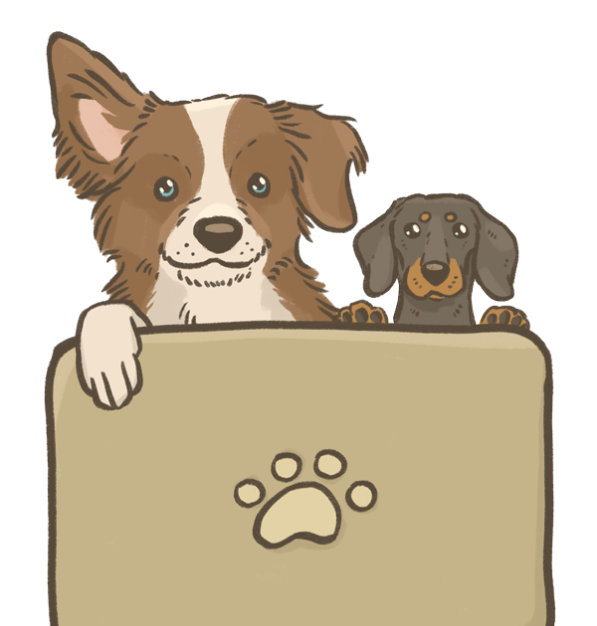Why Dogs Fear Storms and What You Can Do to Calm Them

When thunderclouds start gathering, many dogs already seem on edge, anxious, pacing, panting, or hiding long before we hear the first rumble. This isn’t superstition; dogs genuinely sense storms earlier than humans.
Their acute perception of barometric pressure, static electricity, and low-frequency sound means they experience the storm’s arrival long before we do. What once helped their wild ancestors find shelter can now spark intense anxiety in our pets.
Veterinary research confirms that thunderstorm phobia is one of the most common anxiety disorders in dogs, affecting up to one-third of the population (Storengen & Lingaas, 2015). Understanding the biology behind this fear helps pet parents approach it with empathy and evidence-based care.
Why Dogs are Scared of Storms
Storm phobia develops through a combination of genetics, early-life experiences, and sensory sensitivity, rather than a single bad event. Each dog’s response depends on how these factors interact with their environment and their individual stress threshold.
- Atmospheric pressure & static changes: Dogs can detect subtle drops in barometric pressure and feel static buildup before rain, sensations that can cause discomfort or unease.
- Unpredictable noise: Thunder produces low-frequency rumbles and sudden cracks that are difficult to habituate to.
- Visual and olfactory triggers: Lightning flashes, shifting shadows, and even the scent of ozone act as additional cues that something threatening is coming.
- Trigger stacking: Noise, light, air pressure changes, and human tension often occur together, amplifying fear responses beyond what any single trigger would cause.
This layered sensory overload, known as trigger stacking, overwhelms a dog’s coping system and activates the body’s stress response. When adrenaline and cortisol surge, heart rate and alertness increase, while digestion and appetite shut down, explaining why frightened dogs often refuse food during storms. These physiological changes are part of the body’s ancient fight-or-flight mechanism, designed for survival rather than comfort.
In a landmark study, dogs with thunderstorm phobia showed markedly higher cortisol levels and visible signs of distress such as trembling and restlessness compared with calm control dogs (Dreschel & Granger, 2005). Research further supports that thunderstorm fear arises from the interaction of multiple concurrent stimuli, not sound alone (Okamoto et al., 2024), which helps explain why many dogs begin to show anxiety even before the first thunderclap.
How to Calm a Dog during a Storm:
Building a Safe Space
The best time to support your dog is before the storm arrives. When you first notice them becoming unsettled, guide them to a designated safe space, ideally an interior room such as a bathroom or laundry where thunder and flashes are muffled.
Make this space positive:
- Keep blinds closed and lights dim.
- Play white noise, gentle music, or television for background sound.
- Provide a familiar bed, toy, or your worn T-shirt for comfort.
- Act calmly yourself, as your demeanor directly affects your dog’s emotional state.
Over time, your dog will learn that this room represents safety and predictability, helping them self-regulate when storms approach.
Tools and Techniques to Help Dogs Stay Calm During a Storm

Compression wraps or thunder shirts: These apply steady pressure that can lower visible fear behaviours when introduced positively before storm season.

Desensitisation and counterconditioning: Gradually exposing dogs to recorded storm sounds at low volume, paired with positive rewards, helps reframe the experience and build resilience.

Conditioned relaxation: Teach your dog to associate a mat or cue word with calmness when relaxed, then use it during storm events to signal safety.

Pheromone therapy: Dog appeasing pheromone (DAP) collars or diffusers can provide an added layer of calm by mimicking the comforting scent mother dogs release while nursing. Controlled studies have shown reductions in fear-related behaviours during simulated storms.

Essential oils and aromatherapy: Certain gentle blends, such as lavender or chamomile, may help create a soothing environment when used safely and intermittently. Introduce calming scents outside storm times so your dog links them with relaxation, not fear, and always ensure proper dilution and ventilation.

Short-term medication: For dogs with intense fear, short-acting medications such as clonidine, trazodone, or gabapentin can help reduce panic.
Long-term medication: In severe, recurring cases, daily selective serotonin reuptake inhibitors (like fluoxetine) may be recommended by your veterinarian
A review of noise-related fear treatments concluded that combining medication with behavioural therapy yields the best outcomes (Riemer, 2023). In other words, medication doesn’t replace training, it enables it by helping dogs stay calm enough to learn.
Why Food and Gut Health Still Matter
While dogs in “fight or flight” mode may not eat during storms, their overall biological state influences how well they can recover from stress.
“A dog that is biologically satisfied, meaning their physical, emotional, and nutritional needs are consistently met, is more resilient in the face of acute stressors like storms.”
Emerging research highlights the critical role of the gut-brain axis in emotional regulation. Diets high in refined carbohydrates and additives can promote low-grade inflammation and oxidative stress, which in turn affect the nervous and immune systems. This inflammation makes it harder for the body to maintain balance when stress hormones rise.
Conversely, whole-food, minimally processed diets support a healthy gut microbiome, balanced neurotransmitter production, and improved immune regulation, all factors that enhance a dog’s ability to stay calm and recover quickly from stress.
Simply put, chronic inflammation lowers the emotional threshold. A dog fed in alignment with their biology, with nutrient-dense foods and adequate enrichment, is physiologically better equipped to cope with thunder, fireworks, and daily life’s surprises.
Even probiotics like Big Dog Pet Foods, Stress and Anxiety, can help with a stress response. Healthy dogs handle stress better, inside and out, so this storm season, preparation really is the best protection.
Fireworks vs. Storms
While storms involve multiple sensory triggers, fireworks are primarily a noise-specific stressor, sudden, loud, and unpredictable. Research links fireworks fear to subsequent thunderstorm anxiety due to generalisation (Blackwell et al., 2013).
For predictable events like New Year’s Eve:
- Exercise your dog well earlier in the day.
- Offer sniff-based enrichment such as lick mats or snuffle mats.
- Provide balanced nutrition supporting gut-brain health.
- Prepare your safe space early.
Layered Stress and Biological Fulfilment
Reducing your dog’s baseline stress builds resilience. This layered stress model acknowledges that emotional stability starts with physical and biological wellbeing.
Exercise: Regular movement appropriate for age and breed.
Mental enrichment: Training, foraging, problem-solving.
Rest & routine: Predictability lowers anxiety.
Nutrition: A whole-food, minimally processed diet supports the gut-brain axis, a key regulator of mood.
Social safety: Positive human and canine interactions.
When a dog’s biological needs are consistently met, the body’s stress systems can reset between challenges. Chronic inflammation, nutrient deficiency, or lack of stimulation all erode this resilience over time. Supporting biological fulfilment through diet, environment, and emotional security provides the foundation for steadier behaviour under stress.
A Compassionate Takeaway
Storm phobia isn’t misbehaviour; it’s a genuine emotional and physiological fear. Punishment or scolding only erodes trust and amplifies anxiety. Instead, champion your dog’s emotional wellbeing.
Through calm leadership, biological balance, and, when needed, evidence-based medical support, you can help your pet weather even the fiercest storms with confidence.
About the Author - Dr. Nicole Rous

Dr. Nicole Rous completed her degree with Honours from the University of Sydney in 2008. She initially worked in the UK before returning to small animal practice in Melbourne, Australia. Dr. Nicole has a keen interest in animal reproduction and has been granted Membership with the Australian and New Zealand College of Veterinary Scientists in this specialty. She is also passionate about complementary therapies such as massage and enjoys discussing ways to enhance pets' overall well-being and quality of life.
In August 2021, Dr. Nicole joined the Mont Albert Veterinary Surgery team as a director and continues to provide exceptional care to her patients. She is dedicated to utilising her knowledge and experience to assist pets in living longer, healthier, and happier lives.
Dr. Nicole's commitment to providing natural and holistic health practices for pets inspired her to establish Shy Tiger, a company that offers natural pet products made from premium ingredients sourced primarily from Australian farms and producers. Her expertise in natural health practices and dedication to providing excellent care to her patients make her a reliable partner for pet owners in Melbourne and beyond.
References
Storengen LM, Lingaas F. Noise sensitivity in 17 dog breeds. Appl Anim Behav Sci. 2015.
Dreschel NA, Granger DA. Physiological and behavioural reactivity to stress in thunderstorm phobia. Appl Anim Behav Sci. 2005.
Okamoto K, Inoue K, Kawai J, Yamauchi H, Hisamoto S, Nishisue K, Koyama S, Satoh T, Tsushima M, Irimajiri M. Factors influencing the development of canine fear of thunder. Applied Animal Behaviour Science. 2024; 270:106139..
Riemer S. Therapy and Prevention of Noise Fears in Dogs. Animals (Basel). 2023.
Blackwell EJ, Bradshaw JWS, Casey RA. Fear responses to noises in domestic dogs: Prevalence, risk factors and co-occurrence with other fear-related behaviour. Applied Animal Behaviour Science. 2013; 145(1–2):15–25.
